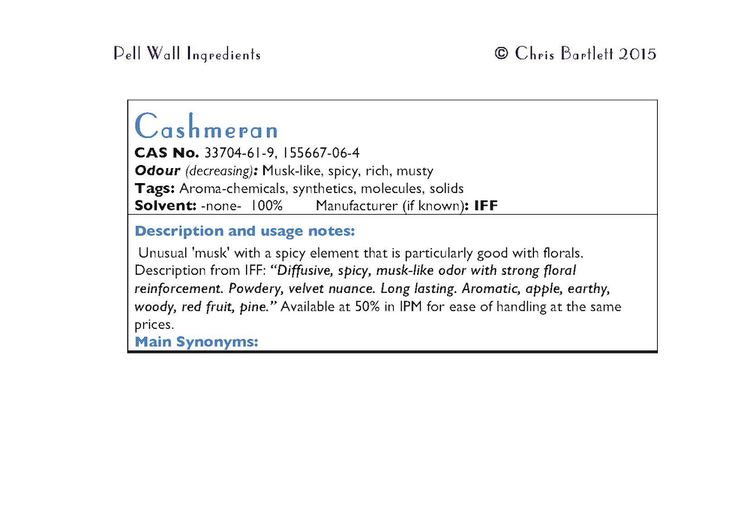Formula C14H22O Boiling point 256 °C Classification Ketone | Molar mass 206.32 g/mol Melting point 27 °C Appearance White solid | |
 | ||
Cashmeran (trade name; also known as musk indanone or indomuscone; chemical name 6,7-dihydro-1,1,2,3,3-pentamethyl-4(5H)-indanone or DPMI) is a chemical compound used in fragrances.
Contents
- Physical chemical properties
- History
- Odour
- Environmental data
- Environmental and human monitoring studies
- Human health
- References

Physical-chemical properties

Cashmeran is an alicyclic ketone with the molecular formula C14H22O and a molecular weight of 206 g/mol. At room temperature it occurs as a white solid but its melting point is 27 °C. Boiling point has been reported to be 256 °C, however in some tests decomposition of the material was noted at 220 °C.
History

Cashmeran was discovered by International Flavors and Fragrances in the 1970s by John Hall. Its invention came about researching inexpensive chemical transformations from ingredients from the pentamethyl indane and tetramethyl naphthalene structures. As a result Cashmeran, an unsaturated ketone, was identified as an important new fragrance ingredient.
Odour

Although cashmeran has been described by some as a polycyclic musk, it is neither primarily a musk odour ingredient, nor does it belong to the polycyclic musk group as defined by the International Fragrance Association (IFRA). The IFRA definition defines a polycyclic musk as:

Although there are woody-musky notes to Cashmeran, its odour is complex with notes that are: rich spicy, fruity, chypre, balsamic and vanilla, overall intended to convey the soft sensuous feeling of cashmere (hence the trade name Cashmeran). As such, cashmeran is used to impart its own characteristic odour, which is completely different from regular musk ingredients. This is further reflected by its typical use level of around 2% compared to for instance the polycyclic musk HHCB (galaxolide) with use levels in fragrances up to 30%. Cashmeran also lacks the aromatic benzene ring structure, which is present throughout the polycyclic musks. Cashmeran should therefore not be categorized as a polycyclic musk.
Environmental data
Cashmeran has a bio concentration factor (BCF) of 156 and an octanol/water partition coefficient (Log Kow) of 4.2, which makes that this material not a very persistent, very bioaccumulative (vPvB), nor a persistent bioaccumulating toxic (PBT) substance. Short term aquatic toxicity for cashmeran is >1 mg/kg for all species (Daphnia, algae and fish). Cashmeran has an environmental hazard classification (R51/53 according to the EU DSD or H411 according to the EU CLP). In this sense, Cashmeran's bio concentration and aquatic toxicity is even an order of magnitude more favourable than those substances considered as polycyclic musks, and therefore also does not meet those criteria for the materials considered to be included in that group.
Environmental and human monitoring studies
Several monitoring studies have been conducted in various environmental compartments and humans. In most studies, DPMI was not detected. Some studies have reported trace levels of DPMI, where the reported levels were below 1 ppm, and typically below 1 ppb. Considering the environmental fate studies, the likelihood of DPMI being present in environmental media is small, and if present, at extremely low levels (i.e. below ppm).
Human health
Cashmeran is a slight skin irritant and an eye irritant (R36/38 according to EU DSD, H315-319 according to EU CLP) and a weak sensitiser (R43/H317) with an EC3 of 33%. Cashmeran is not classified as toxic nor is it a CMR substance
